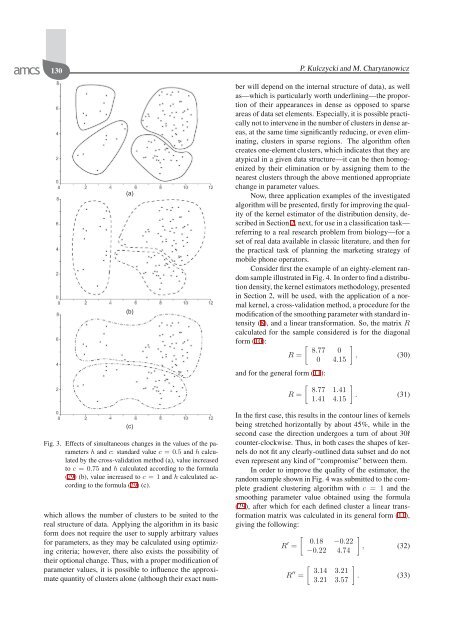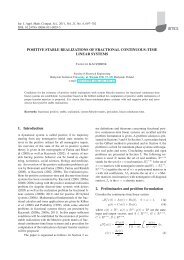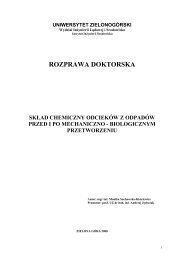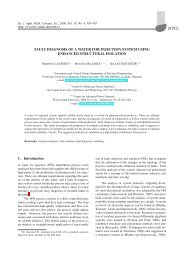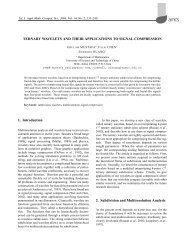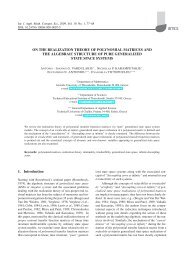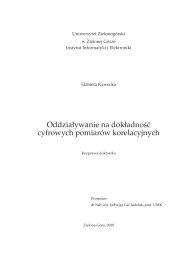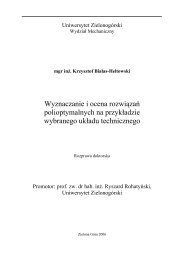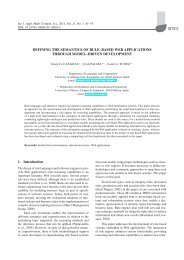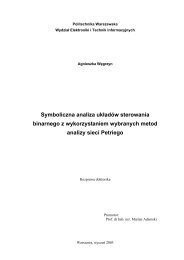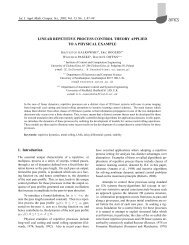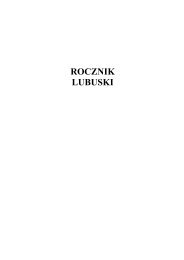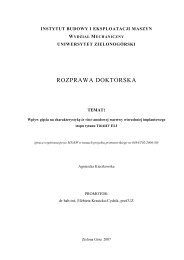A complete gradient clustering algorithm formed with kernel estimators
A complete gradient clustering algorithm formed with kernel estimators
A complete gradient clustering algorithm formed with kernel estimators
You also want an ePaper? Increase the reach of your titles
YUMPU automatically turns print PDFs into web optimized ePapers that Google loves.
130 P. Kulczycki and M. Charytanowicz<br />
(a)<br />
(b)<br />
(c)<br />
Fig. 3. Effects of simultaneous changes in the values of the parameters<br />
h and c: standard value c =0.5 and h calculated<br />
by the cross-validation method (a), value increased<br />
to c =0.75 and h calculated according to the formula<br />
(29) (b), value increased to c =1and h calculated according<br />
to the formula (29) (c).<br />
which allows the number of clusters to be suited to the<br />
real structure of data. Applying the <strong>algorithm</strong> in its basic<br />
form does not require the user to supply arbitrary values<br />
for parameters, as they may be calculated using optimizing<br />
criteria; however, there also exists the possibility of<br />
their optional change. Thus, <strong>with</strong> a proper modification of<br />
parameter values, it is possible to influence the approximate<br />
quantity of clusters alone (although their exact number<br />
will depend on the internal structure of data), as well<br />
as—which is particularly worth underlining—the proportion<br />
of their appearances in dense as opposed to sparse<br />
areas of data set elements. Especially, it is possible practically<br />
not to intervene in the number of clusters in dense areas,<br />
at the same time significantly reducing, or even eliminating,<br />
clusters in sparse regions. The <strong>algorithm</strong> often<br />
creates one-element clusters, which indicates that they are<br />
atypical in a given data structure—it can be then homogenized<br />
by their elimination or by assigning them to the<br />
nearest clusters through the above mentioned appropriate<br />
change in parameter values.<br />
Now, three application examples of the investigated<br />
<strong>algorithm</strong> will be presented, firstly for improving the quality<br />
of the <strong>kernel</strong> estimator of the distribution density, described<br />
in Section 2, next, for use in a classification task—<br />
referring to a real research problem from biology—for a<br />
set of real data available in classic literature, and then for<br />
the practical task of planning the marketing strategy of<br />
mobile phone operators.<br />
Consider first the example of an eighty-element random<br />
sample illustrated in Fig. 4. In order to find a distribution<br />
density, the <strong>kernel</strong> <strong>estimators</strong> methodology, presented<br />
in Section 2, will be used, <strong>with</strong> the application of a normal<br />
<strong>kernel</strong>, a cross-validation method, a procedure for the<br />
modification of the smoothing parameter <strong>with</strong> standard intensity<br />
(8), and a linear transformation. So, the matrix R<br />
calculated for the sample considered is for the diagonal<br />
form (10):<br />
R =<br />
[ 8.77 0<br />
0 4.15<br />
and for the general form (11):<br />
[<br />
8.77 1.41<br />
R =<br />
1.41 4.15<br />
]<br />
, (30)<br />
]<br />
. (31)<br />
In the first case, this results in the contour lines of <strong>kernel</strong>s<br />
being stretched horizontally by about 45%, while in the<br />
second case the direction undergoes a turn of about 30ř<br />
counter-clockwise. Thus, in both cases the shapes of <strong>kernel</strong>s<br />
do not fit any clearly-outlined data subset and do not<br />
even represent any kind of “compromise” between them.<br />
In order to improve the quality of the estimator, the<br />
random sample shown in Fig. 4 was submitted to the <strong>complete</strong><br />
<strong>gradient</strong> <strong>clustering</strong> <strong>algorithm</strong> <strong>with</strong> c = 1 and the<br />
smoothing parameter value obtained using the formula<br />
(29), after which for each defined cluster a linear transformation<br />
matrix was calculated in its general form (11),<br />
giving the following:<br />
R ′ =<br />
R ′′ =<br />
[ 0.18 −0.22<br />
−0.22 4.74<br />
[ 3.14 3.21<br />
3.21 3.57<br />
]<br />
, (32)<br />
]<br />
. (33)


